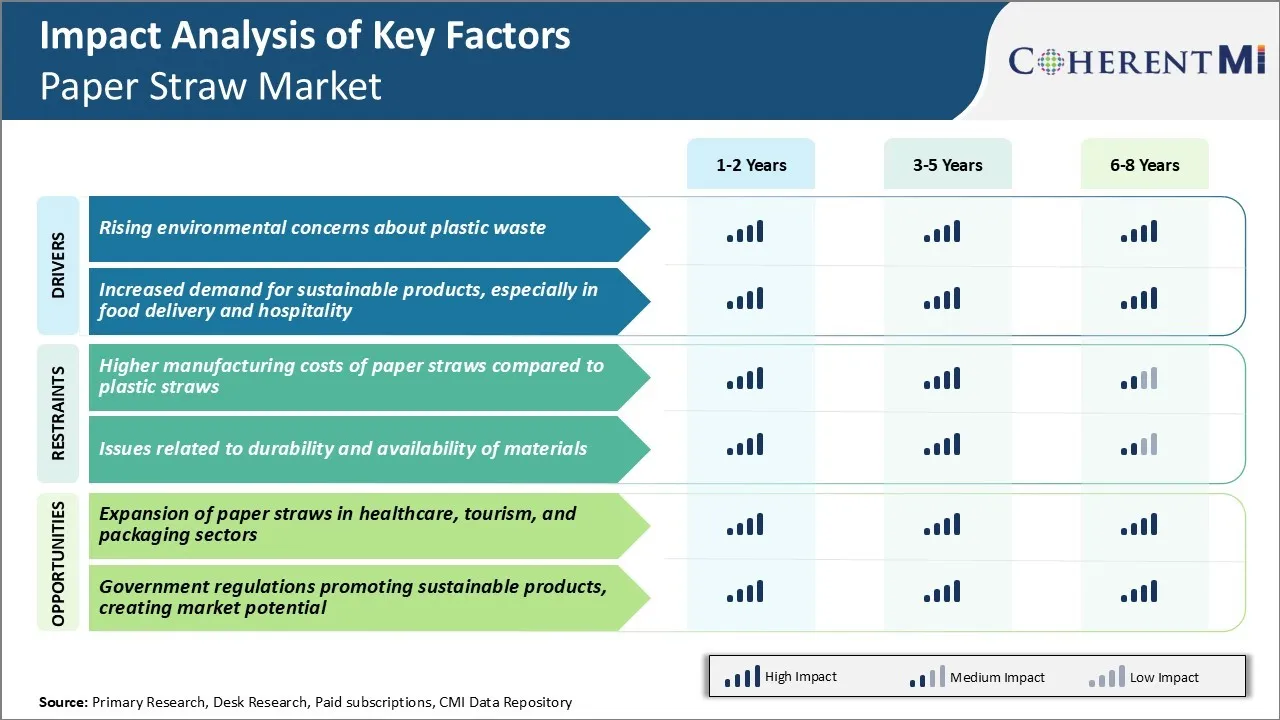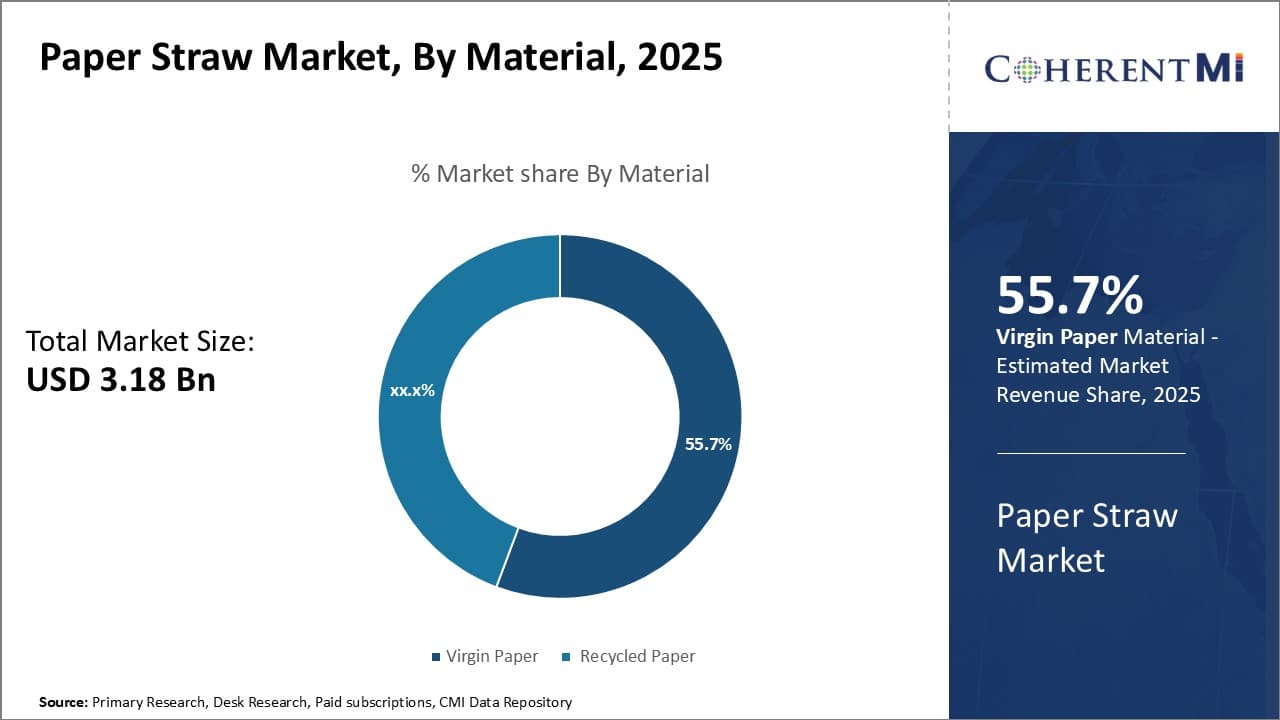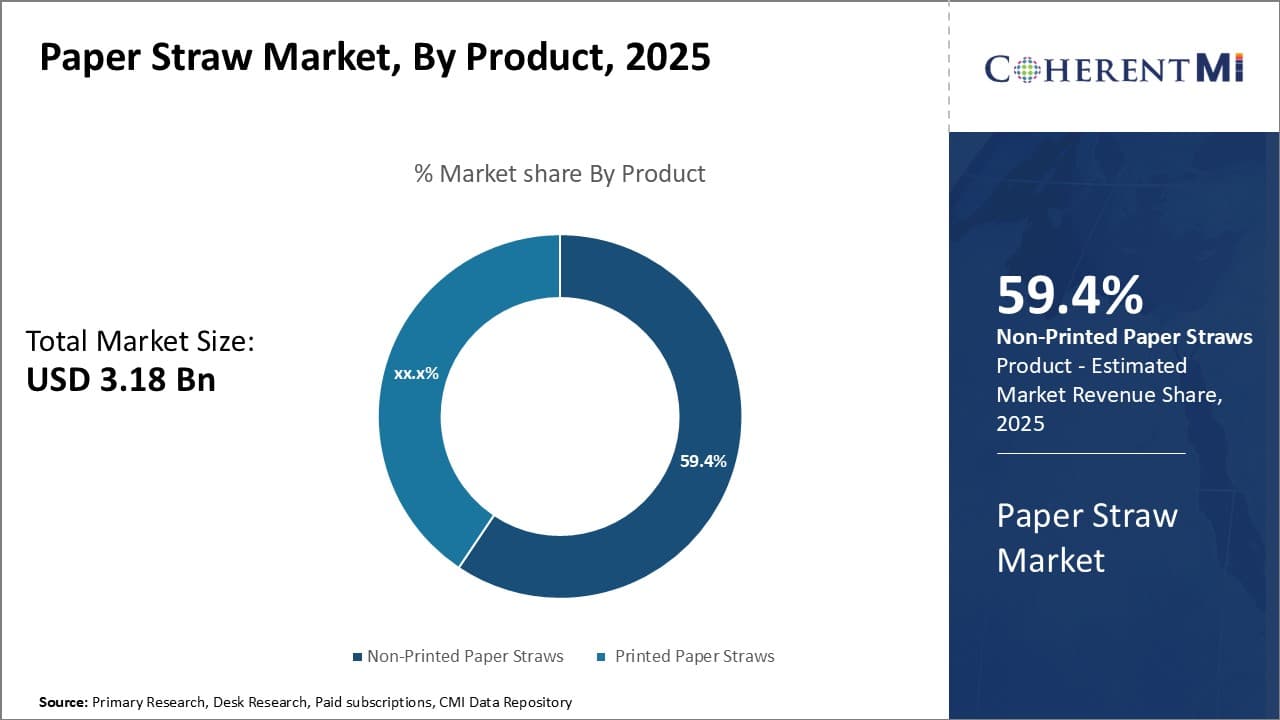Paper Straw Market Size - Analysis
The paper straw market is estimated to be valued at USD 3.18 Bn in 2025 and is expected to reach USD 12.08 Bn by 2032, growing at a compound annual growth rate (CAGR) of 21.00% from 2025 to 2032. Paper straws are seeing increased demand as environmental regulations against plastic straws get stricter around the world. This is expected to boost growth of the paper straw market in the coming years.
Market Size in USD Bn
CAGR21.00%
| Study Period | 2025-2032 |
| Base Year of Estimation | 2024 |
| CAGR | 21.00% |
| Market Concentration | Medium |
| Major Players | Hoffmaster Group, Inc., Footprint, Matrix Pack, Tetra Laval Group, Huhtamaki Group and Among Others |
please let us know !
Paper Straw Market Trends
Market Driver - Rising Environmental Concerns About Plastic Waste
As people become increasingly aware of the environmental damage caused by single-use plastics, there is a growing sentiment against their use. Concerns about plastic pollution have given rise to the global break free from plastic movement. Major economies like the European Union have pledged to ban commonly littered single-use plastic items by 2021. Other countries are following suit with their own plastic waste management strategies and bans.
The paper straw option provides a simple and effective alternative for consumers who want to reduce their plastic footprint. Unlike bulky stainless steel or glass straws, paper straws maintain the portability and convenience that plastic straws offer. Many see paper straws as a viable and pragmatic interim solution until more sustainable packaging systems are developed across industries.
Supply of plastic-free drinking options like paper straws is poised to get a major boost to satisfy the shifting preferences of socially responsible buyers. Manufacturers in the paper straw market are actively marketing their products as eco-friendly options that check the rising demand for earth-conscious alternatives to plastics.
Market Driver - Increased Demand for Sustainable Products, Especially in Food Delivery and Hospitality
Consumers, especially millennials and gen Z, consider a company's environmental and social impact before making purchasing decisions. As they become the dominant spending demographic, businesses recognize the commercial importance of being seen to be eco-friendly. The hospitality and food delivery sectors also generate a vast amount of packaging waste regularly. This makes them prime targets for those seeking more sustainable alternatives.
Many restaurants and cafes have proactively switched to paper straws, lids and cutlery to present green credentials to their customers. Major fast food and coffee chains too have announced plastic reduction plans involving substitutions with biodegradable materials.
Ride-hailing and food delivery platforms are increasingly emphasizing on eco-packaging partnerships. Replacing conventional plastic packaging like straws with paper variants contributes greatly to their sustainability marketing. Besides the gains in customer goodwill and retention, sustainability transitions can aid firms' access to green financing and partnership opportunities as well. This is expected to drive growth of the paper straw market.

Market Challenge - Higher Manufacturing Costs of Paper Straws Compared to Plastic Straws
One of the major challenges currently faced by the paper straw market is the higher manufacturing costs associated with paper straws as compared to plastic straws. Paper straw manufacturing requires more complex production processes and uses more expensive raw materials like virgin wood pulp or recycled paper. This makes the per unit production cost of paper straws at least three times higher than plastic straws.
As plastic straws are made from cheap petroleum-based materials through injection molding, their manufacturing costs are significantly lower. The higher costs make it difficult for paper straw manufacturers to compete on price with plastic straw companies. It also raises the overall price of paper straws for end consumers and businesses, limiting wider adoption.
To drive volumes and achieve economies of scale, paper straw producers need to bring down manufacturing costs substantially through innovations, automation, and improving yields to make paper straws more viable commercially against plastic.
Market Opportunity - Expansion of Paper Straws in Healthcare, Tourism, and Packaging Sectors
One significant opportunity for the future growth of the paper straw market is the expansion into new sectors such as healthcare, tourism and flexible packaging. There is growing demand for eco-friendly straw options from hospitals, restaurants, airlines, hotels and different packaging applications due to stringent waste management regulations and consumer preferences for sustainable products.
Manufacturers in the paper straws market can leverage this demand by developing customized paper straw solutions suitable for these industries and targeting them aggressively. They also need to highlight various advantages of paper like its compostable nature, plant-based origin and recycling abilities. If paper straw makers focus on these expanding sectors, it can help boost volumes and revenues while enhancing the market footprint of paper straws globally. With innovative product development and strategic collaborations, healthcare, tourism and packaging are promising avenues that can drive future expansion of the paper straw market.
Segmental Analysis of Paper Straw Market
 Insights, By Material: Convenience and Sustainability Drive Virgin Paper Market Share
Insights, By Material: Convenience and Sustainability Drive Virgin Paper Market Share
In terms of material, virgin paper segment is expected to account for 55.7% share of the paper straw market in 2025. This is due to consumer preference for convenience and sustainability. Virgin paper straws provide a more robust sipping experience compared to recycled paper straws, which can sometimes be gritty or break down more quickly when wet. The smooth texture and stiffness of virgin paper makes for optimal drinking capability.
Additionally, consumers increasingly seek Eco-friendly solutions and see virgin paper straws as creating less waste than plastic straws or contributing less to environmental pollution compared to recycled paper straws. Manufacturers prioritize virgin paper properties like strength and chemical stability over recycled content at this stage of the paper straw market's development.
As awareness increases regarding recycled paper straw viability, its market share looks set to grow while still playing a supporting role to virgin paper as the leading material in terms of consumer functionality demands.

Insights, By Product: Printed Designs Boost Non-printed Paper Straw Popularity
In terms of product, non-printed paper straws contribute the highest share of the market owing to their widespread use across quick service restaurants and other high-volume establishments. While printed paper straws offer branding opportunities and customizable designs that appeal in specialty and event-based applications, non-printed paper straws are more economical for mainstream operations. Their plain appearance remains suitable for the majority of beverage occasions.
That said, growing interest in unique paper straw décor inspires some businesses to incorporate printed paper straws into their product mix. Examples include whimsical shapes or messages that complement specialty drinks. Non-printed paper straws maintain an edge overall thanks to their ease of use within high-throughput settings. But printed straw innovation hints at elevated potential as a niche enhances mainstream acceptance in the paper straw market.
Insights, By End Use: Food Service Sector Leads Household, Institutional Use
In terms of end use, food service contributes the highest share of the market owing to its vast network of quick service restaurants, cafes, and other retail food operators. As the frontline for on-the-go beverage consumption, the food service industry has the greatest need and ability to supply paper straws on a broad scale.
Household use remains low as well, as people typically drink at home without straws. The economics of scale give Food Service distinctive leverage for sourcing paper straws at competitive costs relative to more specialized sectors. As paper straw adoption expands across the hospitality domain, Food Service may welcome renewable alternatives at performance and price points satisfying mass market needs.
Additional Insights of Paper Straw Market
- North America dominated the global paper straw market in 2023, with a 34% revenue share.
- Asia Pacific is expected to register the fastest growth in global paper straw market at a CAGR of 22.94% from 2024 to 2033.
- The food service segment contributed the largest revenue share of paper straw market, accounting for over 60% of the total demand for paper straws, driven by restaurants, cafes, and bars.
- The European Union's ban on single-use plastics, effective from July 2021, has led to a surge in demand for paper straws as businesses seek compliant alternatives. McDonald's Japan facility also eliminated plastic straws in favor of paper straws to eliminate 900 tons of plastic annually.
- UFlex introduced India's first U-shaped paper straw production line using Dutch technology to produce 2.4 billion paper straws annually.
Competitive overview of Paper Straw Market
The major players operating in the paper straw market include Hoffmaster Group, Inc., Footprint, Matrix Pack, Tetra Laval Group, Huhtamaki Group, Biopac (UK) Ltd., Transcend Packaging, Novolex, Strawland, Jinhua Suyang Plastic Material Co., Ltd., The Paper Straw Co., Vegware Ltd., Aardvark Straws, Southeastern Paper Group, and Canada Brown Eco Products Ltd.
Paper Straw Market Leaders
- Hoffmaster Group, Inc.
- Footprint
- Matrix Pack
- Tetra Laval Group
- Huhtamaki Group
Paper Straw Market - Competitive Rivalry

Paper Straw Market
(Dominated by major players)
(Highly competitive with lots of players.)
Recent Developments in Paper Straw Market
- In early 2024, DS Smith has indeed invested €48 million in its Kemsley paper mill. The investment is part of a broader initiative aimed at improving production efficiency and reducing costs. Specifically, the investment has been directed towards the installation of a new fiber preparation line, which will enhance the mill's ability to process recycled fibre, reduce water consumption, and lower energy usage.
- In August 2023, Transcend Packaging partnered with Klüber Lubrication to use vegetable-origin lubricants in the manufacturing of paper straws. This partnership aims to reduce and eliminate the use of mineral oil aromatic hydrocarbons (MOAH) and mineral oil saturated hydrocarbons (MOSH) in their production process.
- In June 2023, Hoffmaster Group Inc. expanded its production capacity by opening a new manufacturing facility in the United States. This expansion aims to meet the growing demand for paper straws and reduce lead times for customers, strengthening the company's market position.
- In May 2023, IPI SRL was indeed acquired by Oji Holdings Corporation. Oji Holdings, a major player in the global pulp and paper industry, completed the acquisition on May 10, 2023. This acquisition aimed to leverage IPI's technology and expertise in aseptic carton packaging to expand Oji's presence in the paper market, especially in packaging solutions for beverages and liquid food.
Paper Straw Market Segmentation
- By Material
- Virgin Paper
- Recycled Paper
- By Product
- Non-Printed Paper Straws
- Printed Paper Straws
- By End Use
- Food Service
- Institutional
- Household
- By Straw Length
- < 5.75 Inches
- 75-7.75 Inches
- 75-8.5 Inches
- 5-10.5 Inches
- By Diameter
- < 0.15 Inches
- 15 - 0.196 Inches
- 196 - 0.25 Inches
- 25 - 0.4 Inches

Would you like to explore the option of buying individual sections of this report?
Shivam Bhutani has 6 years of experience in market research and strategy consulting. He is a Market Research Consultant with strong analytical background. He is currently an MBA candidate specializing in Business Analytics from BITS Pilani.
He is adept at navigating diverse roles from sales and marketing to research and strategy consulting. He excels in market estimation, competitive intelligence, pricing strategy, and primary research. He is skilled at analysing large datasets to provide precise insights, helping clients in achieving strategic transformation across various industries. He is skilled in leveraging data visualization techniques to drive innovation and enhance business processes.
Frequently Asked Questions :
How big is the paper straw market?
The paper straw market is estimated to be valued at USD 3.18 Bn in 2025 and is expected to reach USD 12.08 Bn by 2032.
What are the key factors hampering the growth of the paper straw market?
Higher manufacturing costs of paper straws compared to plastic straws and issues related to durability and availability of materials are the major factors hampering the growth of the paper straw market.
What are the major factors driving the paper straw market growth?
Rising environmental concerns about plastic waste and increased demand for sustainable products, especially in food delivery and hospitality industry, are the major factors driving the paper straw market.
Which is the leading material in the paper straw market?
The leading material segment is virgin paper.
Which are the major players operating in the paper straw market?
Hoffmaster Group, Inc., Footprint, Matrix Pack, Tetra Laval Group, Huhtamaki Group, Biopac (UK) Ltd., Transcend Packaging, Novolex, Strawland, Jinhua Suyang Plastic Material Co., Ltd., The Paper Straw Co., Vegware Ltd., Aardvark Straws, Southeastern Paper Group, and Canada Brown Eco Products Ltd. are the major players.
What will be the CAGR of the paper straw market?
The CAGR of the paper straw market is projected to be 21.00% from 2025-2032.